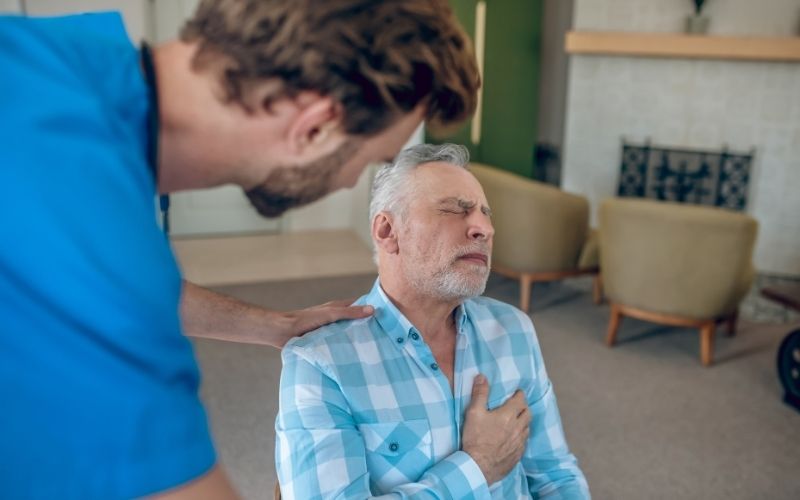Sudden cardiac arrest, or SCD, is one of India’s leading causes of death, with an estimated 5 to 6 lakh people dying yearly. And what’s even more worrying is that a sizeable percentage of them are under 50. Sadly, over 86% of these deaths could have been prevented through timely treatment and prevention. Read on to learn more about cardiac arrest treatment, including lifestyle changes to avoid cardiac arrest.
What Is Cardiac Arrest?
Sudden Cardiac Arrest is when the heart stops beating, causing it to stop pumping blood. The lack of blood flow to the brain and other vital organs suddenly causes the person to lose consciousness. Without immediate treatment, the person could become disabled or even die. Sometimes, the heart beats so fast that it stops pumping.
There are no early signs of a cardiac arrest, hence called sudden cardiac arrest. But if you notice a loved one collapse suddenly or lose consciousness and isn’t breathing or is gasping for air, chances are, they are having a cardiac arrest. Such patients also do not respond to shouting and do not have a pulse as well.
The patient may complain of chest discomfort, weakness, or a fast-beating heart just minutes before cardiac arrest.
What To Do If You Suspect Someone Might Have A Cardiac Arrest?
Sadly, only 10 to 12% of people with cardiac arrest outside of a hospital survive. The only way you can prevent deaths is by increasing awareness about administering cardiopulmonary resuscitation (CPR) and defibrillation using an automated external defibrillator (AED). Call the ambulance immediately if you know of a loved one who may be suffering from cardiac arrest. And if you know CPR, administer it until help arrives.
What Happens During A Cardiac Arrest?
Heartbeats are triggered by electrical impulses. When these impulses can be too slow or too fast – such changing patterns cause the heartbeat to beat irregularly. This is called arrhythmia. During a cardiac arrest, the rhythm stops absolutely.
What Causes Cardiac Arrest?
Cardiac arrest causes include
· Ventricular Fibrillation:
Ventricular fibrillation refers to the rapid heartbeat in the heart’s ventricle, i.e., the heart’s lower chambers. When this happens, the heart trembles rather than pumps blood normally. This type of arrhythmia is one of the leading causes of sudden cardiac arrest.
· Atrial Fibrillation:
Atrial fibrillation refers to arrhythmia in the upper chambers, i.e., atria. When the sinoatrial node in the right atrium doesn’t send out the correct electrical impulses, the ventricles cannot pump blood efficiently.
Conditions that could trigger a cardiac arrest include arrhythmia, cardiomyopathy (where the heart muscles dialate or thicken), and coronary artery disease (where the arteries are narrowed due to plaque blockages, thereby affecting blood flow).
Cardiac Arrest Vs Heart Attack: How To Recognise The Difference?
People often interchange the terms cardiac arrest and heart attack, but these are two different heart conditions. A heart attack occurs when the arteries are blocked due to plaque, thereby affecting blood supply. As a result, the heart muscles weaken and even die. Cardiac arrest occurs when the heart suddenly stops beating. Unlike in a cardiac arrest, the heart doesn’t usually stop beating in a heart attack.

Cardiac Arrest Treatment
Cardiac arrest treatment involves increasing the flow of oxygen-rich blood to the vital organs. This is done through CPR or cardiopulmonary resuscitation and is performed when someone compresses the chest to replace the heart’s pumping. CPR helps move small amounts of blood to the brain, thereby helping the patient survive until an external defibrillator arrives.
Automated External Defibrillator
When you call an ambulance, the emergency medical personnel carry a defibrillator. This machine sends an electric shock to the heart to help it function normally. It not only saves a person’s life but also contains organ damage caused due to lack of oxygen and lack of blood flow.
While defibrillators weren’t commonly available everywhere and only restricted to hospitals, ambulances, etc., the Indian Medical Association has demanded the installation of AEDs in public places like railway stations, airports, and government buildings. Given the increasing instances of cardiac arrest in India, even private properties are installing AEDs to ensure better chances of survival. As a result, more and more gyms, residential buildings, corporate offices, etc., are opting to install AEDs to avoid death due to cardiac arrest.
If you survive a cardiac arrest, the doctor will start you on treatment to prevent another attack. This includes medication, surgery, dietary changes to lose weight, etc. If you’re into smoking or alcohol, the doctor will suggest quitting these habits.
Cardiac Arrest After Care
Cardiac arrests can be deadly. But if you are lucky to have received timely cardiac arrest treatment, it is essential to prevent a further attack and pay attention to your health. As a part of your cardiac arrest aftercare, you must lose weight, quit smoking, and take medication regularly.
Looking For A Heart Specialist In Nagercoil?
Calwin Hospitals is one of the best places offering affordable cardiac care in Nagercoil. As a reputable heart hospital in Nagercoil, we provide a range of cardiac arrest treatments, including bypass surgeries, valve replacement and various stenosis treatments. We regularly conduct cardiology and ophthalmology camps in and around Kanyakumari to raise awareness about heart health. We even recently conducted a heart health checkup camp on World Heart Day.
Call now to schedule an appointment to learn how to prevent cardiac arrests.
Visit us at Calwin Hospital, Nagercoil’s best multispeciality heart care facility, for world-class cardiac treatment and compassionate care
